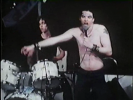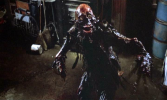Reviews
Penelope Spheeris
USA, 1981
Credits
Review by Victoria Large
Posted on 08 September 2011
Source 16mm print
Categories American Punk
The Decline of Western Civilization, Penelope Spheeris’ chronicle of the Los Angeles punk scene of the late seventies and early eighties (filming took place from December 1979 to May 1980), makes a fitting companion piece for Lech Kowalski’s Sex Pistols documentary D.O.A. Both films provide us with incendiary, tough-to-shake live performances, but they also treat punk with honesty and more than a little ambivalence. Spheeris’ film - her feature debut - is particularly sharp in this regard. Wisely resisting the temptation to present the L.A. scene as a homogeneous whole, Spheeris seems to heed the words of French fanzine editor and punk frontman Claude Bessy (a.k.a. Kickboy Face), who tells her that unlike members of previous subcultures, “We’re not all grooving on the same vibes anymore. We’re grooving on different vibes… ugly vibes.”
Early in the film, Spheeris succinctly frames Los Angeles punk as a willfully volatile response to the dominant consumer culture of the seventies, and indeed, as a rejection of the tarnished glamour of L.A. itself. Brendan Mullen, owner of the L.A. punk club Masque, describes punk as “protest music” in an interview, memorably drawing a environmental link to the desperation and anger evident in so much of the music: “The air in utopia is poisoned,” he says, with an expansive view of the city just over his shoulder. Spheeris’ subsequent up-close-and-personal live footage of Black Flag (who then featured Ron Reyes as their lead singer) tearing through abrasive tracks like “Depression” and “Revenge” is well-placed, helping us key into the ferocity of punk as well as its very real cathartic value.
A legendary appearance by the Germs raises the specter of physical violence more vividly and troublingly. In dryly funny interview excerpts, the Germs’ manager, a young woman named Nicole, talks about the group being banned from various clubs due to violence at shows and the bad reputation that followed. She likens her job to “being the mother of four three-year-olds” and adds that she sometimes wants to “batter” her children. A note onscreen at the end of the Germs’ segment wryly acknowledges that she quit her managerial gig on April 1, 1980. Of course, when placed in context, the interview with Nicole is strictly gallows humor: Germs singer Darby Crash, known for self-destructive stage antics like diving through broken glass, died of a heroin overdose before the film’s release, a few months after his twenty-second birthday.
In an interview conducted in his kitchen (where one wall is grimly decorated with a headline about the murder charges brought up against Sid Vicious), Crash speaks frankly about getting loaded before every show - on absolutely anything he get his hands on - anaesthetizing himself in order to perform. “That way I don’t have to feel myself getting hurt,” he says. Crash also points to drugs as the reason he so frequently fails to sing into the microphone. In concert segments, his performances - all slurred vocals and bellowing screams - are riveting, rude, and raw, but they’re juxtaposed with footage of Crash playing with a pet tarantula, looking childlike as he lets the arachnid crawl up his arm. As a director, Spheeris is a sympathetic but truthful observer, and her segments with Crash capture something of the singer’s complexity, if only briefly.
Spheeris gives us a fuller sense of the L.A. scene with performances from The Alice Bag Band (a.k.a. The Bags) and The Circle Jerks, and she also interviews the staff of the punk fanzine Slash. That section of the film includes memorable footage of Bessy and his band Catholic Discipline, as well as an interview where Bessy rather definitively excoriates the term “New Wave.” But it may be Spheeris’ work with the band X that best complicates her exploration of the L.A. scene.
X would eventually become one of the most well known and financially successful of the bands profiled, and that’s hinted at even here: amid talk of many of the acts being banned from venues, X’s segment opens with them receiving a bouquet of roses from the management at the Whisky-a-Go-Go. Later, X singer Exene Cervenka will wonder if they’ll still be able to sing their song “We’re Desperate,” if they’re, well, not.
The band’s onstage presence is perhaps more telling. They offer up driving, gritty rock (their rendition of “Johny Hit and Run Paulene” is especially scorching), but there’s a more traditional, rockabilly tinge to their sound, and a more positive edge to their performances. Guitarist Billy Zoom (who amusingly eschews the DIY tattoos that the other members are partaking of during an interview segment) can be seen grinning widely when he plays, and vocalist and bassist John Doe is often smiling too. It’s not that they’re happy, exactly - Doe calls their outlook “realistic” - but they seem to know how to take pleasure from their art. As Cervenka says, “I don’t consider myself a happy person, but I had fun tonight.”
A different filmmaker - perhaps a lesser filmmaker - might have chosen X for the film’s grand finale, leaving the audience on a possibly more hopeful note, but that would have been wrong for The Decline of Western Civilization. Instead, Spheeris brings us more performances and some iconic interviews with real teenage punks, whose answers reveal both the internal violence of the L.A. scene and the vague and expansive nature of the malaise that spawned it. “My friends got beat up by my friends,” says Eugene, a young man with a shaved head. He later lists some of the things that make him angry, including “old people,” “buses,” and “dirt.”
Spheeris concludes the film with the controversial and confrontational band Fear, whose appearance in this film would endear them to John Belushi and lead to their infamous, destructive booking as a musical guest on Saturday Night Live. We see Fear singer Lee Ving baiting his audience with insults and homophobic remarks and getting in a violent altercation with a female punk who gets onstage. It’s the kind of thing Fear is known for, and whether one thinks their provocation is irredeemably offensive or considers it as a kind of self-conscious performance art, it would be tough to deny that it’s ugly by design.
Spheeris’ film sees punk as an ugly - if frequently exhilarating - response to an ugly society, and when her utterly exhausting, utterly essential documentary winds down with Fear tearing through “Let’s Have a War” (sample lyrics: “Let’s have a war/So you can go die”) complete with Ving singing a few bars of “The Star Spangled Banner” to end the song, the point is driven home. A friend of mine asked me if the film’s title refers to the punks in the film or the society that spawned them. I think it’s intentionally ambiguous.
More American Punk
-

Times Square
1980 -

D.O.A.: A Rite of Passage
1980 -

The Decline of Western Civilization
1981 -

The Return of the Living Dead
1985 -

Suburbia
1984 -

Border Radio
1987 -

Desperate Teenage Lovedolls
1984 -

The Blank Generation
1976
We don’t do comments anymore, but you may contact us here or find us on Twitter or Facebook.



